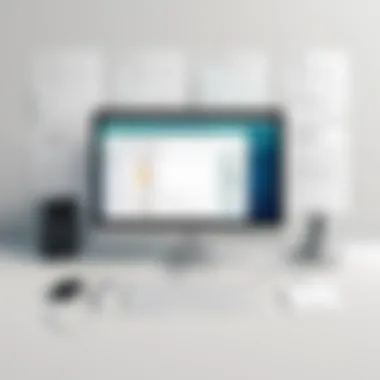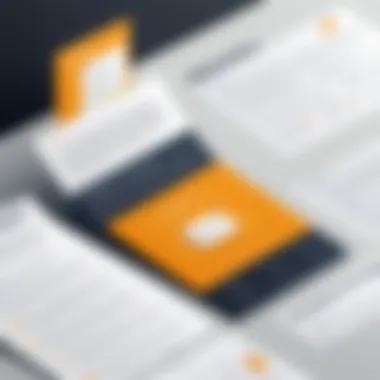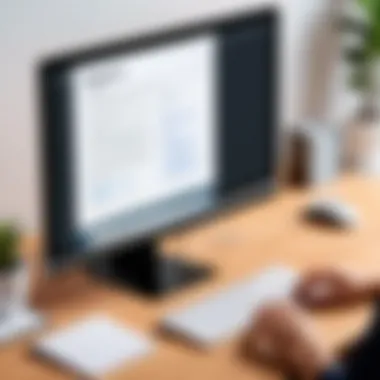Top Websites for Reliable Plagiarism Checks


Intro
In today's academic and professional landscape, the significance of originality cannot be overstated. Plagiarism poses serious ethical implications, affecting not just reputation but also academic standing and career prospects. This emphasizes the vital role played by plagiarism detection tools. They help individuals ensure their work maintains integrity and adheres to the standards expected in various fields.
This guide delves into the world of plagiarism detection websites, providing a comprehensive review of their features, capabilities, performance, and reliability. From students aiming to submit papers free of copied content to professionals needing to ensure their documents are unique, this resource aims to equip users with the knowledge needed to select the right tools.
Let’s explore the features that distinguish these services from one another.
Understanding Plagiarism
Plagiarism is a critical issue that affects various domains such as academia, business, and creative industries. Understanding the concept of plagiarism is essential for anyone involved in writing or creating original content. This section provides a foundation for recognizing the different facets of plagiarism, its implications, and the necessity of plagiarism checks.
Definition of Plagiarism
Plagiarism can be defined as the act of presenting someone else's work, ideas, or intellectual property as one's own, without proper acknowledgment. It is not limited to direct copying of text; it encompasses a wide range of actions, including improper paraphrasing and failure to cite sources adequately. Identifying what constitutes plagiarism can help individuals avoid unintentional misconduct.
Types of Plagiarism
Understanding the various forms of plagiarism is crucial in preventing it. Generally, these include:
- Direct Plagiarism: This occurs when a person copies another's work word-for-word without crediting the source.
- Self-Plagiarism: When an author reuses their own previously published work without acknowledging it, this is considered self-plagiarism.
- Mosaic Plagiarism: This kind involves mixing copied material with one's own without proper citation, leading to a deceptive representation of originality.
- Accidental Plagiarism: Often unintentional, this happens when an individual fails to cite sources correctly or paraphrases poorly.
Understanding these types aids in the development of ethical writing practices.
The Consequences of Plagiarism
The repercussions of plagiarism can be severe and far-reaching. In academic contexts, it can lead to penalties such as failing grades, suspension, or expulsion from educational institutions. For professionals, the stakes are equally high, risking damage to reputation and even legal consequences. Furthermore, organizations may face loss of credibility and trust, which can be detrimental in competitive landscapes.
"Plagiarism is not just a violation of ethical standards; it's a breach of intellectual honesty that can tarnish careers and reputations."
Thus, understanding and avoiding plagiarism is essential for maintaining integrity in any field. The importance of plagiarism checks cannot be overstated, as they play a vital role in upholding originality within written work.
The Importance of Plagiarism Checks
Plagiarism checks serve as an essential mechanism for upholding integrity within both academic and professional settings. In an era where information is widely shared and accessible, the risk of inadvertently copying someone else's work increases significantly. Utilizing a plagiarism checker mitigates this risk, ensuring that individuals maintain originality in their writing. Furthermore, the implications of not checking for plagiarism could lead to severe consequences, including disciplinary action in educational institutions and reputational damage in professional fields. Therefore, understanding the importance of plagiarism checks is crucial for anyone who engages in writing, from students to seasoned professionals.
Maintaining Academic Integrity
Academic integrity is a foundational principle in educational environments. It emphasizes the importance of honesty and transparency in scholarly work. Plagiarism undermines this integrity, resulting in loss of credibility and academic penalties. Institutions often require students to submit work through plagiarism detection systems such as Turnitin or Grammarly. These tools help ensure that students understand proper citation practices and foster a culture of originality. When students submit original work, they enhance their learning experience and stand by the ethical standards established by their institutions.
Protecting Original Work
Protecting original work is vital for authors, researchers, and content creators. When individuals create new material, they invest time and resources into those efforts. Plagiarism not only discredits the original creator but can also lead to financial losses or legal ramifications. Tools like Copyscape and Unicheck are designed to detect unauthorized use of text, allowing creators to safeguard their work. Moreover, a robust plagiarism checker can highlight similarities in content, prompting authors to revise or properly attribute sources before publication. This ensures that creativity and innovation are recognized and valued.
Building Trust in Professional Environments


In professional settings, reputation is often as important as the quality of work produced. Businesses and organizations are expected to uphold ethical standards, which includes giving credit where it is due. Using plagiarism detection tools reinforces trust among colleagues, clients, and stakeholders. When teams verify work for originality, they promote collaboration and respect for individual contributions. This dedication to ethical practices can enhance a company's image and foster strong partnerships. Overall, investing in plagiarism checks can have far-reaching effects, ensuring that both individuals and organizations maintain high ethical standards in their operations.
Criteria for Choosing a Plagiarism Checker
When selecting a plagiarism checker, it’s important to consider several key factors. These criteria ensure that the tool you choose is appropriate for your specific needs. The right plagiarism checker enhances the reliability of your work while providing a user-friendly experience. Understanding these criteria is vital to make an informed decision.
Accuracy and Reliability
Accuracy is arguably the most critical aspect of a plagiarism checker. The tool you select must provide precise results to identify plagiarized content effectively. Reliable software uses extensive databases and algorithms to scan documents. It ensures that original content remains untarnished by mistakenly flagged text. The quality of the results often depends on how robust the database of the checker is. Reliable checkers also update their databases regularly. This helps maintain effectiveness against new content and emerging issues in plagiarism.
User Interface and Experience
User experience plays a major role in the overall effectiveness of a plagiarism checker. A well-designed interface allows users to navigate the software easily. Checkers should feature straightforward submission processes and clear result displays. Enhancements such as highlighting plagiarized sections and providing instant feedback are beneficial. If the tool is difficult to use, it can lead to frustration and reduced efficiency. Thus, opt for plagiarism checkers that emphasize simplicity in navigation.
Cost-Effectiveness
Cost is a crucial factor when choosing a plagiarism checker. Evaluate whether the pricing structure aligns with your budget while still meeting your needs. Some checkers offer free versions, but these may come with limitations in features and database access. Paid versions usually offer more comprehensive services. Look for tools that offer subscription models. Such models can provide significant savings for frequent users. Ultimately, the goal should be to find a balance between affordable pricing and quality functionality.
Additional Features
Beyond basic plagiarism detection, various additional features can enhance the functionality of a checker. For instance, some tools provide grammar checking and style suggestions. Others may offer integration with writing software or even educational platforms. These features can provide a more holistic approach to content creation. Keep an eye out for tools that include reporting capabilities. Detailed reports can be useful for academic or professional purposes, offering deeper insights into the plagiarism severity.
"Selecting the right plagiarism checker hinges on understanding your specific requirements and identifying the tool that best meets them."
In summary, choosing an appropriate plagiarism checker involves examining key criteria such as accuracy, user experience, cost, and additional features. By assessing these elements thoroughly, users can ensure they select a tool that preserves the integrity of their work.
Popular Websites for Plagiarism Detection
In the digital age, maintaining originality in writing is increasingly vital. Plagiarism detection websites help individuals and organizations safeguard their content. They ensure that the work presented is unique, and they provide crucial information for preventing intellectual theft. Understanding the benefits of these tools can significantly impact academic and professional integrity.
Turnitin
Turnitin is widely recognized in academic circles. It offers comprehensive plagiarism detection services that go beyond mere text matching. This platform checks submitted documents against an extensive database of student papers, academic publications, and content available on the internet. Educators often use Turnitin to assess students’ writing and ethical practices. The feedback provided helps students improve their writing skills over time.
Grammarly
Though Grammarly is primarily known for its grammar-checking capabilities, it also includes a built-in plagiarism checker. This tool compares the text against online content to identify similarities. For writers concerned about originality, Grammarly offers a convenient option. Its user-friendly interface allows seamless integration into various writing platforms. Users appreciate its ability to enhance both clarity and conciseness while ensuring that the content remains original.
Copyscape
Copyscape specializes in detecting plagiarism for online content. It has a straightforward approach to identifying duplicate content on the web. This makes it especially valuable for bloggers, marketers, and webmasters. Copyscape's premium version allows users to enter a URL to check for copied content. It also provides resources to assist users in crafting unique articles.
Quetext
Quetext combines advanced technology with a simple user interface. It employs deep search technology, which allows for a more thorough check of original compositions. Quetext is effective for both students and professionals. Users can access a free version with limited functionality or upgrade for more in-depth reports. Its attractive design and efficient service have made it a preferred choice in the plagiarism detection realm.


Plagscan
Plagscan is another powerful tool in the market. It caters to both individuals and institutions with its customizable services. Plagscan checks documents against various databases, including academic and web sources. They offer solutions to ensure that students and faculty adhere to ethical writing standards. Additionally, Plagscan provides detailed reports, making it easier for users to understand potential issues and address them effectively.
Unicheck
Unicheck is known for its real-time results and accuracy. It efficiently scans documents through multiple sources, offering extensive reports on potential plagiarism. The software is especially useful for educational institutions, as it integrates well with learning management systems. Users can quickly identify issues and take corrective action, fostering a culture of originality within the academic environment.
Choosing the right plagiarism detection tool can greatly enhance your writing process. Each tool offers unique features and benefits.
How to Use Plagiarism Checkers Effectively
Using plagiarism checkers is not just about scanning a document and receiving a report. To gain maximum benefits from these tools, one needs to understand the process and the potential impact of their results. This section elaborates on how to use these tools effectively, enhancing not only the quality of work but also ensuring authenticity.
Preparing Your Document
Before submitting a document to a plagiarism checker, it is crucial to prepare it properly. This step involves several key considerations. First, ensure that the document is in the right format. Most online tools accept formats like .doc, .docx, or .pdf. If your file is in a different format, convert it before you begin.
Next, make sure the text is complete and polished. Check for grammatical errors, typos, and formatting issues before running the checker. A clean document will yield clearer results. Also, consider removing any sections that were directly copied from sources without proper citation. This can give an accurate reflection of your originality.
Finally, include comments or notes if your document requires specific attention to certain areas. This sometimes helps in understanding the outcome better when you interpret the results.
Interpreting the Results
After the plagiarism checker has analyzed your document, it provides a report with various metrics. Understanding what these metrics mean is vital for making informed decisions. Most tools will return a similarity percentage, indicating how much of your text matches other sources.
- Low Similarity (0-15%): This generally indicates high originality.
- Moderate Similarity (16-40%): This suggests some overlaps. Investigate which parts match and consider revising those sections.
- High Similarity (Above 40%): A high percentage indicates a significant amount of text that could be flagged as unoriginal. In this case, a thorough review and revision are necessary.
Also, pay attention to the highlighted sections in the report. These provide a clear view of exactly which portions of the text are problematic. The references to the matched sources will assist you in evaluating whether proper citation was made.
"Understanding the results is as crucial as the detection itself; the next steps depend on it."
Making Necessary Revisions
Once you have interpreted the results, the next step is to make necessary revisions. Depending on the level of similarity returned by the checker, this task can vary significantly. If your document has a low similarity score, minor tweaks might suffice, such as paraphrasing or adding citations.
For documents that show higher similarity, a more comprehensive revision may be required. This often involves:
- Paraphrasing: Rewrite sections in your own words while maintaining the original meaning. This is essential for improving originality.
- Citing Sources: Ensure that all references are appropriately cited in the text. Not only does this improve your credibility, but it also can significantly lower the similarity score.
- Removing or Replacing Sections: Sometimes, sections heavily flagged should be reconsidered entirely. If the content is not essential, removing it may be the best choice.
The approach you take depends on the context of your document. Whether academic, professional, or creative, ensuring originality will reflect positively on your work.
Plagiarism in Different Contexts


Understanding the context of plagiarism is essential for various stakeholders, including students, professionals, and creatives. Plagiarism can manifest differently depending on the setting, leading to unique challenges and consequences. This section will examine the significance of plagiarism in academic, business, and creative environments, detailing how each context requires different approaches to maintain integrity and originality.
Academic Settings
In academic environments, plagiarism is a serious offense that can lead to severe penalties. Institutions often have strict policies regarding originality in research and writing. Students are expected to produce work that reflects their understanding and insights. The presence of plagiarism undermines these expectations and devalues the educational process.
Effective plagiarism checkers can help students verify their work before submission. For example, tools like Turnitin and Grammarly not only check for copied content but also provide feedback on writing quality. This allows students to learn proper citation practices and develop their writing skills. Furthermore, recognizing the importance of originality in research helps foster a culture of honesty and integrity among students.
Business and Corporate Environments
In business settings, plagiarism may not only damage reputations but can also lead to legal repercussions. Companies invest significantly in their brand identity and the authenticity of their intellectual property. When employees present work that contains plagiarized elements, they risk the organization’s credibility and may even face disciplinary actions.
Utilizing plagiarism detection tools in corporate environments can safeguard against such risks. Programs like Copyscape and Unicheck help ensure that all content generated for marketing, reports, or internal documents remains original. This practice not only protects the company's assets but also reinforces a culture of innovation and creativity.
Creative Industries
Within creative industries, originality is paramount. Artists, writers, and designers thrive on unique ideas and expressions. Plagiarism can stifle creativity and result in significant legal issues, such as copyright infringement.
To respect intellectual property and maintain originality, professionals in creative fields can benefit from tools like Quetext or Plagscan. These resources help in vetting work, providing peace of mind that their creative output is truly their own. Moreover, artists and creators are often inspired by existing works, making it crucial to understand how to build on others' ideas without crossing ethical boundaries.
Future Trends in Plagiarism Detection
As technology evolves, so does the methodology behind plagiarism detection. It is essential to understand the future trends in this field, especially for those who prioritize academic integrity and originality. Future advancements will not only enhance the detection process but also increase the reliability of results. Students, educators, and professionals must stay updated with these trends to maintain the credibility of their work.
Advancements in AI Technology
Artificial Intelligence (AI) is revolutionizing various sectors, and plagiarism detection is not an exception. AI's ability to analyze vast amounts of data efficiently enables plagiarism checkers to identify similarities between documents more effectively. This advancement leads to a decrease in false positives, providing a more accurate assessment of originality. Furthermore, AI algorithms can adapt and learn from new patterns in writing, offering a dynamic approach to detecting plagiarism.
The integration of AI can streamline the document checking process. Instead of relying solely on traditional keyword matching techniques, which may miss nuanced plagiarism, AI can evaluate the context and meaning of the text. This improvement opens new avenues to enhance the capabilities of existing tools and provides unprecedented support to users who wish to ensure the originality of their work.
The Role of Machine Learning
Machine learning, as a subset of AI, plays a crucial role in advancing plagiarism detection technologies. By leveraging machine learning models, plagiarism checkers can learn from past analyses, refining their algorithms over time. This process improves both the precision and recall rates of these tools.
The ability of machine learning to process large datasets means that it can evaluate different writing styles, tones, and formats. Professionals in IT-related fields can benefit greatly from this, as they often deal with diverse documentation types. With machine learning, plagiarism detection tools can update their databases continuously, thus staying current with emerging trends in writing and citation styles. This adaptability is vital in keeping up with the evolving nature of academic and professional writing.
Finale
In this article, we have examined the significance of plagiarism detection tools and their role in fostering originality within various contexts. Understanding the nuances of plagiarism, including its definition, types, and consequences, underscores why using effective plagiarism checkers is essential. As technology continues to evolve, tools available today offer much more than mere text comparison. They enhance writing by ensuring integrity and originality.
Recap of Main Points
- Understanding Plagiarism: We discussed the meaning, various forms, and potential repercussions associated with plagiarism. This comprehension is vital for anyone engaged in academic or professional writing.
- The Importance of Plagiarism Checks: They maintain academic integrity, protect original work, and build trust in professional settings. Neglecting this aspect can lead to significant consequences.
- Criteria for Choosing a Plagiarism Checker: Factors such as accuracy, user experience, cost, and advanced features were highlighted as critical in selecting the appropriate tool.
- Review of Popular Websites: The examination of platforms like Turnitin, Grammarly, and Copyscape provided insights into their functionality and effectiveness.
- Using Plagiarism Checkers Effectively: Strategies for preparing documents, interpreting results, and revising content were discussed to ensure the best results.
- Contextual Considerations: Understanding how plagiarism influences various sectors—academic, corporate, and creative—emphasizes the universal need for originality.
- Future Trends in Plagiarism Detection: Advancements in AI and machine learning are expected to further enhance the capabilities of plagiarism detection tools.
Final Thoughts on Choosing the Right Tool
Selecting the correct plagiarism detection tool is not merely about finding duplicates but ensuring that your writing reflects integrity and authenticity. Before deciding on a specific platform, consider the intended usage.
- For academic purposes, solutions like Turnitin or Unicheck might be more suitable due to their educational focus and comprehensive database.
- If your primary need is content creation or blogging, Grammarly or Copyscape might offer the functionalities you require without the extensive database needed for academic checks.
In summary, the correct choice can greatly influence the quality and credibility of your work. The landscape of plagiarism detection is continuously shifting, so staying informed about options and innovations is crucial for maintaining originality and upholding standards.







